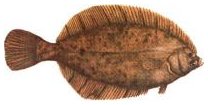NJ Saltwater Fishing Articles
- Details
- Category: Fishing Articles
- Published: Wednesday, 07 March 2007 10:41
- Hits: 50423
 Hi! I'm Capt. Anthony W. Reina. My first job landed me part-time on the deck of a local Point Pleasant party boat during the winter of 1992. Since 1995, I have been fishing for Winter Flounder on the Manasquan River and the northern part of Barnegat Bay. In the fall of 2003, I purchased Angela Rose and have been a professional charter guide since. Winter flounder fishing is one of my specialties. I would like to share with you some of my knowledge, tactics, experiences and strategies that I employ when I am targeting these fish.....
Hi! I'm Capt. Anthony W. Reina. My first job landed me part-time on the deck of a local Point Pleasant party boat during the winter of 1992. Since 1995, I have been fishing for Winter Flounder on the Manasquan River and the northern part of Barnegat Bay. In the fall of 2003, I purchased Angela Rose and have been a professional charter guide since. Winter flounder fishing is one of my specialties. I would like to share with you some of my knowledge, tactics, experiences and strategies that I employ when I am targeting these fish.....
Just like most of you, I also suffer from cabin fever. Winter Flounder fishing is the cure to get me out of the house and wet the line for the first time. It marks the "official" start of my 2007 season. We all know that winter months can get extremely brutal and unpleasant. The Winter of 2007 was uncommonly warm during the months of December and January. However, out of the woodwork, old man winter dealt us a wicked cold February. Temperatures are finally starting to get back to normal as March is settling in. During November and December, flounder crowd the rivers, bays, and tributaries to spawn. After the spawning run is over, they start to make their journey back to the ocean and eventually to their summer grounds along the edge of the continental shelf. During that time, it is our passion to catch our limits and feast. I want to discuss the techniques I've found most successful in landing you a good catch.
In order to catch Winter Flounder, you have to know where to catch them. Location is key. During the beginning of the season we will fish as far back as the Mantaloking Bridge, "18," or the Island. As the school of Winter Flounder start their easterly exit midway in the season, you can find them inside the Manasquan River in spots such as the Hospital, Riviera Beach, or the "6/7" hole. At the end of the season, good locations such as The Path, Bathtub, Kings Hole or the "2" will hold fish and then eventually we will chase them right out of the Manasquan Inlet. Once you establish where you are going to fish, you will find flounder in 3 basic areas. These locations consist of mud flats, channels, and holes. These winter fish will stage in the deeper channels, holes and in the mouths of the main tidal creeks like Beaver Dam Creek and feed from the shallow flats. I prefer to fish the flats regularly. The sun heats the mud around the flat and gets them active. Once they are active, you'll find that most of the fish that are caught are dressed in the mud. Another spot are the edges of muscle beds. Winter Flounder work only along the edges and not on top of the beds. Broken and crushed mussels from anchors, sinkers, large boats running aground, or storm damage provide an easy meal.
Now that we know where to fish, what can we do to improve our chances of catching fish. Chum! I make my own chum based on an improvised recipe that goes back way before my time. I take a 5-gallon bucket of saturated dog food, and not just any dog food, but a good size kernel or nugget consisting of corn meal as the main ingredient. I will then mash it to a thick paste and then add crushed clamshells, clam waste (from shucked bait) boiled white rice, and muscles that I snatch off of pilings and docks. I mix it all well and I then fill 1/2 inch mesh chum pots. Place the pots on the bottom and up current. The slick will fall back to where your hooks and bait are.
So we have our location and chum slick in the water and now we have to get them in the boat. Tackle is simple. Choosing your tackle is more of a self-preference. If you like to fish light or medium, I cannot tell you what rod and reel outfit you should fish with. Granted Winter Flounder provide the most fun when caught on light tackle. Most anglers use a light to medium action spinning rod with 6-12 pound test monofilament line. A rig consists of a No. 8 or 9 sized snelled flounder hook with a 12 inch leader attached to each end of a wire spreader with a yellow painted bank sinker attached to its center. This is known as a spreader rig. An alternative rig can be easily assembled by passing the end of the line through a fish finder then attach a black swivel to it. Use a snelled flounder hook with a yellow bead, attaching the loop end to the swivel and attach a yellow bank sinker to the fish finder.
Now that you have your rod and rig set, your going to want to bait up. Choosing your bait isn't that difficult. Bloodworms, sandworms, clams, and muscles are your four (4) basic choices. I personally like you use the muscles from a clam. They prove to be very effective baits and last a long time. I caution you to make sure you don't cut your bait too big. In this case, big bait doesn't always mean big fish. Your bait should be 2-4 inches in length. Remember that Winter Flounder have small mouths and they suck their prey in.
I always fish the Manasquan River and Barnegat Bay for Winter Flounder. The information I am sharing with you will work equally as well in any waters that harbor Winter Flounder, including the Great Bay, Shark River and Raritan Bay. I will leave you with ten (10) solid tips and one of my favorite spots to help you land more fish.
- When fishing from a boat, if applicable, use two anchors. Keeping your boat steady over a hole or bank will produce results, especially when you are chumming. You don't want your boat to slide all over the river.
- Try to match the hatch. After your first day out, while cleaning your catch, check the contents of the stomach. This will give you a good idea of what bait to bring out on your next trip. When you find out what the flatties are feeding on, stay with it.
- If you have a couple of minutes before heading out, use a fine-meshed net with a long-handle and work along dock pilings and bulkheads to collect grass shrimp. Grass shrimp is also on the flounders diet.
- Play the tide. Flatties become most active 1-2 hours before, or after slack high or low tide. Plan your trips and the locations you select accordingly, Remember that there is a nearly a full tide change between Manasquan Inlet and the Mantaloking Bridge. Check your tide tables and plan your day based on tides.
- Stir up the mud! Bounce a window sash weight or take a toilet plunger and attach a telescopic handle and bounce it off the bottom around your boat or dock. By bouncing your plunger AND sinkers, your stirring up the mud which is then flowing down current. The flounder see this and with the scent of chum in the water, they will go looking for food!
- Once in a while give your chum pot a good shake. If the bite is slow, you may want to let a little extra chum escape out of the pot. Also don't be afraid to smash a handful of clam shells around your boat or dock.
- Patience is a virtue, your in a waiting game. Try not to jump to too many locations. Stick it out for a little bit. Give your chum time to work. Let your tools do the work. When setting the hook on a flounder, also be patient. Give the fish time to eat. By swinging on the first nibble or bite, you could easily remove your bait and hook right out of the fish's mouth.
- Don't be afraid to go off away from the fleet. After a congregation of boats or fisherman sit on one spot the stock will eventually diminish Find a spot where nobody is fishing or hasn't fished. There may be fish there and no one even knows about it.
- Fish frequently. The more time you fish the more fish you will catch. Last time I checked, I didn't see any fish walking down the road. You have to be out on the water to produce great numbers.
- Watch and learn. If you have the opportunity to fish with somebody who knows what he or she is doing, watch and learn. Flounder fishing is not something that you will pick up overnight but, simple tricks of the trade that you will learn from the experienced, will make worlds of difference. I owe nearly all of my fishing knowledge to my father, Capt. Wayne. Without him to watch over me, I would not be in the position I am in today.
One of my favorite fishing spots is the mouth of the Point Pleasant Canal on the Manasquan River side. If your fishing from land, fish the old hospital side of the canal but cast out towards Treasure Island. There is a really deep hole northeast by the red day board. Boaters are recommended to anchor between the red day board and the green can that marks the channel going up river towards the Rt. 70 Bridge. Of coarse, take all safety precautions to make sure you do not impede the flow of boat traffic.







